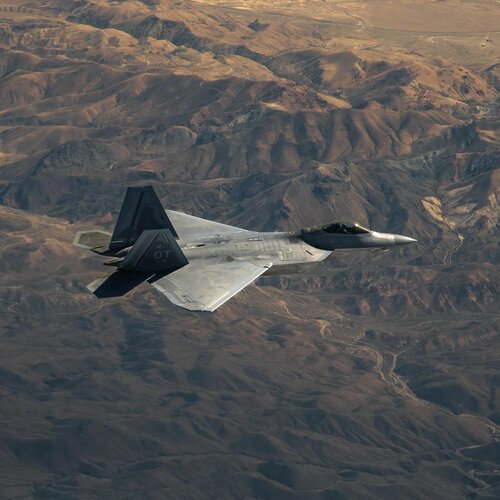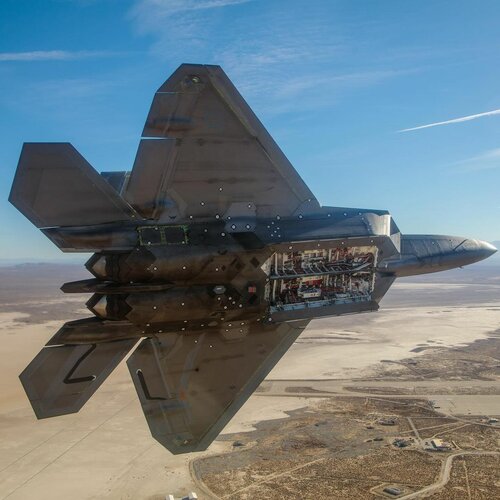aonestudio
I really should change my personal text
- Joined
- 11 March 2018
- Messages
- 2,964
- Reaction score
- 7,493



About a year ago, the US Air Force was asking to cut a significant number of early model F-22s from its 183-Raptor inventory.
In 2023, the US Air Force lodged a plea to retire its fleet of 32 F-22 Raptor Block 20 units currently in operation. Furthermore, the USAF requested for the budget originally allocated for upgrading these planes to be rerouted into the development of the sixth-generation combat aircraft also referred to as the Next Generation Air Dominance [NGAD].
This proposal encountered a roadblock in Congress when discussed in the framework of the FY23 National Defense Authorization Act, a document that was published in December 2023.
But the US Air Force has now designated the Raptor as its “highest priority”.
Referring to the military competition with China at a McAleese Defense Programs conference in Washington DC, US Air Force acquisition chief, Andrew Hunter, said, “F-22 is a critical capability. So what’s my highest priority in the near term for that great power competition? I’d probably put F-22 at the top.”
Hunter's statements indicate the possibility of retaining and upgrading an undisclosed quantity of the older F-22s manufactured by Lockheed Martin during the late 1990s and early 2000s.
US Air Force Chief of Staff Gen. David Allvin offered a comment on upgrading older F-22s, saying “we’re looking to be able to take those that are the most combat-capable, keep them in the fight, and then leverage some of the resources for those that are going to be cost prohibitive and time prohibitive.”
In this video, Defense Updates analyzes why the F-22 is still considered the “highest priority” in a potential conflict with China?
Chapters:
00:11 INTRODUCTION
02:59 EXCELLENT FLIGHT DYNAMICS
04:19 SUPER SITUATIONAL AWARENESS
06:27 GENUINE STEALTH PROFILE

Interesting, is there any idea what is in the pods yet?
It’s a combination of EW and EO/IRST. Had F-22 production continued, the IRST would likely have been internal. Granted, you minimize the impact if you can tailor the shaping as a whole and dump most of the additional returns into aspects where there are already RCS spikes, but it’s still not as ideal as an internal sensor which is likely too expensive at this point to retrofit. Money and budget matters.Interesting, is there any idea what is in the pods yet?
I wish the F-22 could have gotten this level of interest in expanding its capabilities back when we were still producing them.
now they are sticking 500 litre tanks under the wing
US gallon? Roughly 1000 litres, tornado had 1500 litres as standard, and 2250x 2 as long range.More like 500 gallon tanks.
US gallon? Roughly 1000 litres, tornado had 1500 litres as standard, and 2250x 2 as long range.
I still can’t see it as viable. As fuel….
I have real difficulty in seeing those inboard pods as fuel tanks. I can’t see how the very limited amount of fuel they could contain, cancelling out the drag, to give a net gain.
Fuel, yanks have been using conformal tanks for 20+ years, now they are sticking 500 litre tanks under the wing, a la ww2 typhoon, I don’t think so.
500gallons is about 1900 liters.US gallon? Roughly 1000 litres, tornado had 1500 litres as standard, and 2250x 2 as long range.
I still can’t see it as viable. As fuel….
Not sure ofc, but i think those ones are big subsonic tanks.The tanks have been designed to have very low drag. The F-22 can fly supersonically with them.
Not sure ofc, but i think those ones are big subsonic tanks.
Big and not overly streamlined, like supersonic tanks tend to look.
And, frankly speaking, subsonic range/loiter time extender does make sense for Pacific.
Don't remember high drag tanks and pylons, so this line of reasoning is not convincing.There is a reason they are called Low Drag Tank and Pylon.
Don't remember high drag tanks and pylons, so this line of reasoning is not convincing.
Most likely cause of such name is simply outgrowth of some work to optimize airflows.
But unless specifically declared to be such, this just isn't how supersonic tanks tend to be like.
Also they need to drop them when necessary correct? Alot of research went into dropping and return f-22 to its clean original RCS signature.
A conformal fuel tank wouldn't work.
When they pop off the LDTP the pylon comes off too, resulting in a "clean" configuration both in terms of signature and drag.
There'd need to be some sort of spring-loaded flap to mask the exposed pylon connections on the the wings undersides to prevent degradation of the F-22's radar-signature.
Interesting, is there any idea what is in the pods yet?


F-22 Spotted With New Stealth Wing Tanks, Infrared Sensor Pods
Stealthy fuel tanks and pods containing infrared search and track sensors will help bridge the gap between the F-22 and what's to succeed it.www.twz.com
Don't remember high drag tanks and pylons, so this line of reasoning is not convincing.
Most likely cause of such name is simply outgrowth of some work to optimize airflows.
But unless specifically declared to be such, this just isn't how supersonic tanks tend to be like.
Their priorities were (hypothetically):
1. Drag
2. Capacity
3. Signature
The tanks are optimized for transonic and supersonic drag, to allow the aircraft to supercruise with minimal penalty. The tanks are designed specifically for the F-22 - both signature and aerodynamics. Using the same tanks on an F-35 or F-16 would see no or negative benefit. Most other external tanks are not optimized for a specific aircraft.
Other external tanks - like those used on the F-16 and F-15 - ARE high drag tanks and pylons. They are not optimized to reduce their impact on performance other than range. The standard external tanks and pylons used on the F-22 significantly impact performance. They are not optimized for the F-22 mission.
Let's talk about what's gone into this massive $16.2 billion overhaul of the world's most capable air superiority fighter that's been underway since 2018 — including what new capabilities the upgraded Raptor will bring to bear, and what all of this means for the forthcoming Next Generation Air Dominance fighter slated to replace the Raptor by the close of this decade.

Curtis-Wright?
Today, it no longer makes aircraft but makes many related components, particularly actuators, aircraft controls, valves, and surface-treatment services. It supplies the commercial, industrial, defense, and energy markets. It makes parts for commercial and naval nuclear power systems, industrial vehicles, and oil- and gas-related machinery.
the F119's DEEC is supplied by Hamilton Standard.
Actually Hamilton Sundstrand, after another corporate merger. Sundstrand built the Main Fuel Pump for the F119 before the merger. All part of Raytheon Technologies Corp (RTX) , along with P&W and others.If you want another Raptor-related throwback to the old days, the F119's DEEC is supplied by Hamilton Standard.
That's certainly what I'd heard...Any details available on it? I'm because someone mentioned in another thread (I can't recall which one it was) that the F-22's FCS use 80386 CPUs.
That's certainly what I'd heard...
Just that the main computers were 80386 series. And therefore pretty much impossible to replace.Any further details, please?
Just that the main computers were 80386 series.
Same era/generation as 386s, though.Umm, no. Something more advanced, and rare. Intel 80960 (i960MX), presumably Mil Spec screened.
https://www.militaryaerospace.com/c...cent-electronics-but-plan-for-future-upgrades
https://en.wikipedia.org/wiki/Intel_i960
